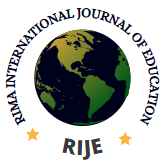Girl-Child Education: A Geniune Tool for Poverty Reduction and Inclusive Development
*1Oluwole Olajide Ogunbanjo and 2Taiwo Oluwasesan Moyib
*1&2Department of Agricultural Education, Sikiru Adetona College of Education Science and Technology (SACOETEC) Omu Ajose (formerly Tai Solarin College of Education, Omu-Ijebu), Ogun State, Nigeria Email: oluwoleolaogunbanjo@gmail.com1 & moyibtaiwo26@gmail.com
Abstract
Girl-child education refers to the aspect of education that aims at developing the skills and knowledge of girls and women from all castes, races, and backgrounds. In Nigeria, like many other developing countries, girl-child education has often been neglected due to deep-seated cultural beliefs and economic difficulties that cut across the land, from the North to the south and from the East to the West. This paper, therefore, examined girl-child education issues concerning poverty reduction and development within the setting of Nigerian society. The rampancy, causes, implications, and remedies were conspicuously highlighted with a deliberate focus on girl-child education as a tool for its reduction as well as enhancing inclusive development amidst the persistent social problems facing the nation. The concept of girl-child education was explicitly discussed. Benefits and challenges facing girl-child education as well as implications for inclusive development were also discussed. The paper observed that Nigeria is still struggling to meet its set target of a poverty-free nation despite several governments’ efforts on girl-child education. The paper eventually offered appropriate solutions and recommended among others that the government should aggressively invest in girl-child education by ensuring that girls and women have access to quality education for the much-desired positive impacts on the larger economy and the overall inclusive development of the nation.
Keywords
Girl-child, Education, Poverty, Reduction, Development, Nigeria
Reference
Ada, N. A. (2007). The girl-child in Nigeria: Policies and challenges. Child Rights Advocacy Press.
Adebayo, O. (2021). Education and gender disparity in Nigeria: A policy review. Lagos Press
Afolayan, M. O. (2018). Gender inequality in Nigerian education: Causes and consequences. Journal of Educational Development, 12(3), 45-60.
African Development Bank. (2022). Investing in girls’ education in Africa: Key to sustainable development. https://www.afdb.org
Adichie, C. N. (2018). We should all be feminists. Anchor Books.
Amnesty International. (2021). Shamed and blamed: Pregnant girls’ right to education. https://www.amnesty.org
Brookings Institution. (2022). Education in emergencies: Protecting girls during crises. https://www.brookings.edu
Education International. (2019). Female teachers and girls’ education outcomes. https://www.ei-ie.org
Edward Ishiaku, 2021. The Challenges of Girl-Child Education, A Case Study of Yobe State, North-East Nigeria. KALU Institute.
European Journal of Social Sciences. (2021). The role of education in poverty alleviation. https://eujournal.org
Federal Ministry of Education. (2005). National Plan of Action for the Education of Girls. Nigerian Educational Research and Development Council.Grace, A. (2010). Barriers to girls’ education in sub-Saharan Africa. Global Education Review.
Federal Ministry of Education. (2014). Safe School Initiative implementation framework. Nigerian Educational Research and Development Council.
Federal Ministry of Education. (2015). National Commission for Mass Literacy, Adult and Non-formal Education: Annual report. Nigerian Educational Research and Development Council.
Federal Ministry of Women Affairs. (2006). National Gender Policy. Federal Government Press.
Global Partnership for Education (GPE). (2021). Girls’ education: A lifeline to development. https://www.globalpartnership.org
Human Rights Watch. (2019). “They don’t want us educated”: Barriers to education for girls in Nigeria. https://www.hrw.org/report/2019/09/12/they-dont-want-us-educated/barriers-education-girls-nigeria
Human Rights Watch. (2021). Barriers to girls’ education and gender equality. https://www.hrw.org
ILO. (2021). Child labor and gender disparities. https://www.ilo.org
Malala Fund. (2020). The economic benefits of girls’ education. https://malala.org
Mukhtar, Y., Bello, A., & Ibrahim, M. (2011). The concept of girl-child education in Northern Nigeria. Journal of Gender Studies, 5(2), 34-49.
National Child Welfare Policy. (1989). Federal Republic of Nigeria.
Obinaju, Q.I. (2014). Gender Issues in teaching as a profession, in E.N. Okpara (EN) Gender Issues in Education and Development. A Book of Reading (Vol. 8,) Enugu. University Trust Publishers .https://www.worldbank.org/en/topic/girls-education/overview
OECD. (2019). The pursuit of gender equality: An uphill battle. OECD Publishing. https://doi.org/10.1787/9789264281318-en
OECD. (2020). Education financing in low-income countries. https://www.oecd.org
Okafor, R. (2019). Child marriage and education in Northern Nigeria. Journal of African Studies, 14(3), 45-60.
Okey, O.J. (2012). The Society and the Girl Child in the Bluest Eye by Toni Morrison and Kaine Agary’s Yellow Yellow. A project submitted to the Department of English, Faculty of Management and Social Sciences, Caritas University, Amorji-Nike, Enugu State. https://www.centreforafricanjustice.org/girls-education-in-nigeria accessed July 5, 2023.
The Guardian Nigeria. (2023, January 15). Nigeria now world’s poverty capital – Tonye Cole. https://guardian.ng
Tyoakaa, Lazarus Mvendaga, Amaka, John Ifeanyichukwu And Nor, Apine (2014).Problems And Challenges of Girl-Child Education in Nigeria: The Situation of Kalgo Local Government
Area (L.G.A) Of Kebbi State. IOSR Journal of Research & Method in Education (IOSR JRME) e-ISSN: 2320–7388,p-ISSN: 2320–737X Volume 4, Issue 4 Ver. IV (Jul-Aug. 2014), PP 01-05 www.iosrjournals.orgn https://www.reliefweb.int/report/world/13-reasons-why-girls-are-not-school-international- day-girl-child accessed 11 August 2023.
UNDP. (2022). Nigeria’s multidimensional poverty index. United Nations Development Programme Nigeria. UNESCO. (2019). Education transforms lives. UNESCO Publishing.
UNESCO. (2020). Global education monitoring report: Gender review. https://en.unesco.org/gem-report
UNICEF (2007): Global Initiative on Out-of-School Children: UNICEF and the UNESCO Institute for Statistics.
UNICEF. (2007). The state of the world’s children: Women and children – The double dividend of gender equality. UNICEF
Universal Basic Education Commission. (2020). UBE programme: 20 years of implementation. UBEC.
United Nations. (1948). Universal declaration of human rights. https://www.un.org/en/universal-declaration-human-rights/
UN Women. (2019). Progress of the world’s women: Education and empowerment. United Nations.
United Nations. (2020). Women’s leadership and political participation. https://www.unwomen.org
UN Women. (2020). Progress of the world’s women 2019–2020: Families in a changing world. United Nations.
UN Women. (2021). Progress on the Sustainable Development Goals: The gender snapshot 2021. https://www.unwomen.org
WHO. (2020). Violence against children in schools. https://www.who.int
World Bank. (2018). Missed opportunities: The high cost of not educating girls. World Bank Group
World Bank. (2013). Nigeria economic report No. 1. World Bank Group.
WPC (2023): World Poverty Clock. Available online https://www.eujournal.org, Accessible online.
